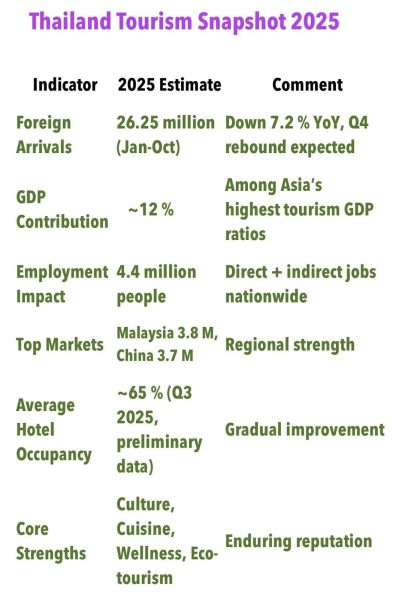BANGKOK, 5 November 2025: Despite global headwinds, Thailand’s tourism industry remains the cornerstone of the nation’s economy, contributing about 12% of GDP and employing over 4.4 million people.
While some reports highlight short-term dips in arrivals, the broader truth is that Thailand’s tourism continues to adapt, evolve, and reaffirm the country’s place as one of the world’s most admired and welcoming destinations.

Global headwinds, local resilience
The world’s travel map has been redrawn by events far beyond Thailand’s control.
The ongoing war in Ukraine has compelled airlines to reroute long-haul flights, resulting in increased distance, time, and cost. Industrial strikes across Europe, North America, and Australia have disrupted schedules and unsettled travellers. Inflation and fuel prices remain stubbornly high.
Even so, Thailand has continued to welcome more than 26 million international visitors so far this year, with daily arrivals averaging around 100,000 – a remarkable figure by any global measure.
Tourism: A cornerstone of prosperity
Travel and tourism are not just economic drivers; they are an integral part of Thailand’s culture and identity. From hotel staff and chefs to farmers, artisans, and guides, tourism supports the livelihoods of people in every region.
Infrastructure investment remains strong. The Eastern Economic Corridor, airport upgrades, and expanding rail links are enhancing connectivity, while luxury eco-resorts, wellness retreats, world-class spas, and community-based tourism projects are shifting Thailand’s focus towards quality, sustainability, wellness, and shared local benefits.

Sustainability is supreme
Without a strong commitment to sustainability, no tourism model can thrive in the long term, and Thailand’s leadership recognises this. The Ministry of Tourism and Sports, the Tourism Authority of Thailand, and private-sector partners have made sustainability a central focus of their policies and initiatives. Thailand now focuses heavily on communities that support tourism directly, encouraging farm-to-table dining, local craft sales, and village experiences that keep tourism income where it matters most. This approach protects natural and cultural assets while strengthening the bond between visitor and host – the essence of Thai hospitality.
Inspiring trends in 2025
• China and Malaysia remain Thailand’s top two markets, both showing renewed confidence.
• Domestic tourism thrives as Thais rediscover their own country through short breaks, festivals, and wellness escapes.
• European and Middle Eastern visitors are returning, especially for luxury, wedding, and MICE segments.
Travellers increasingly seek authentic, sustainable, and culturally rich experiences-areas where Thailand excels.
Why Thailand’s tourism thrives
Thailand’s enduring appeal is built on more than beauty. It offers excellent value for money, genuine hospitality, easy access, and a dazzling array of experiences. From tropical seas to misty mountains, from jungle trails to golden temples, from elephants and orchids to bustling street markets, Thailand’s variety is unmatched.
And then there’s the food — bold, fragrant, joyful, one of the finest cuisines in the world. People travel halfway around the planet just to taste it again.
Thailand’s tourism is good: inclusive, sustainable, and full of human warmth. It brings joy to visitors while empowering communities. Critics may focus on numbers, but good tourism has never been about counting heads; it’s about creating memories and meaning.
Warning signs and the road ahead
Challenges remain; inflation, currency shifts, and environmental pressures must be managed carefully. Yet Thailand is meeting these with energy and imagination through:
• Expanded eco-tourism certification and green hotel standards.
• Ongoing airport and transport upgrades.
• Digital and AI-driven marketing to reach new audiences.
• Closer ASEAN cooperation to balance long-haul volatility.
• Visa-ease policies and strong airline partnerships to sustain premium travel.
These steps ensure Thailand remains Southeast Asia’s most resilient and admired destination.
A welcoming world, Thai style
So yes, numbers rise and fall, currencies strengthen and slip, and forecasts get rewritten. But Thailand keeps the welcome light on.
The beaches still sparkle, the smiles are still real, and somewhere a tuk-tuk is still honking cheerfully at sunset.
The next time someone says “tourism is down,” smile politely — you’ll know better. Thailand’s tourism is good: resilient, sustainable, and unforgettable. It lives not in spreadsheets but in the scent of jasmine rice, the sound of temple bells, and the laughter shared over plates of pad thai.
About the author
Andrew J Wood is a British-born travel writer and former hotelier who has called Thailand home since 1991. A graduate of Napier University in Edinburgh, he served as General Manager for several leading hotels and is a former Director of Skål International, having twice served as President of Skål Bangkok and as Past President of both Skål Thailand and Skål Asia.







Thank you very much for featuring THE BARAI Spa in your article. We truly appreciate the beautiful inclusion and your continued support in showcasing Thailand’s hospitality to the world.
Thank you very much Health, wellness and longevity are firmly entrenched in TAT’s key promo pillars. The Barai is a stand out example -truly world class!
Hi Andrew,
A very positive article — and rightly so, as Thailand truly has it all to offer, whether for foreign or domestic tourism.
Like many other destinations, Thailand faces its share of warning signs and market fluctuations each year. One of the biggest challenges when year-on-year arrivals flatten is the continued surge in hotel room supply. The growth in Bangkok alone from 2023 to 2025 will have added approximately 10,000 new rooms that would require over 700,000 additional visitors for 2026 (assuming an average length of stay of three nights) — and that’s just for Bangkok. Add to that the increase in hotel development across the rest of the Kingdom, and the scale of the challenge becomes clear.
As Andreas noted, it will be interesting to see how stakeholders navigate these dynamics. Exciting times ahead!
Hi Francis,
Many thanks for your thoughtful note, much appreciated.
You are absolutely right. Thailand truly has it all, but the warning signs and fluctuations are real and need careful attention. The numbers you mention are striking. Ten thousand new rooms in Bangkok alone, plus the wider national pipeline, means we are heading into a period where smart strategy will matter more than ever. As you point out, that kind of supply increase demands hundreds of thousands of extra visitors, and the market will need agility and collaboration to absorb it.
The coming months, as many have said, will be fascinating to watch. There is certainly no shortage of talent and experience in our industry, and I remain optimistic that Thailand will continue to adapt, innovate, and find its way forward, just as it always has.
Thanks again for sharing your insight, and congratulations to you and the Landmark team for continuing to set such a strong example in Bangkok’s competitive landscape.
Warm regards,
Andrew